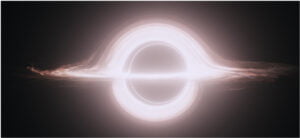
Artist’s impression of lensing around a blackhole. Credit: Oliver James et al., 2015 Class. Quantum Grav. 32 065001
Powerful radio emission produced from jets of relativistic particles is a key indicator of super-massive black holes at any redshift. Many super-massive black holes, with masses around one billion times that of the Sun, have been discovered in the first billion years of the Universe. However, few of them are very powerful in the radio despite such powerful radio emission being common from such black holes at later times. This project will take on three complementary approaches to make progress in finding these missing, and likely obscured, super-massive black holes in the early Universe.
First, you will search for bright radio sources with faint counterparts in the latest generation of wide-area near-infrared surveys (including state-of-the-art data from the Euclid satellite) with the goal of identifying prime candidates for follow-up with the world’s most powerful telescopes.
Second, you will compile radio data on known super-massive black holes with powerful radio emission at slightly later times in the Universe in order to model what we might expect from the earliest super-massive black holes and compare with your new candidates.
Third, you will model the radio luminosity distribution of super-massive black holes in the early Universe and add beaming of the radio jet to estimate how many of the radio sources will be beamed and by how much.
| Student attributes | |
| Academic background | Some astrophysics is preferred, but a general physics background is essential. |
| Computing skills | Some python development preferred plus willingness to explain programming skills. |
| Training requirement |
| Project timeline | |
| Week 1 | Inductions and project introduction, background reading and familiarisation with resources |
| Week 2 | Initial presentation, selection of candidates high-z radio galaxies |
| Week 3 | Identify host galaxies in deep wide-field surveys |
| Week 4 | “ |
| Week 5 | Compare radio spectra to those of known high-z radio-loud AGN extrapolated to higher redshifts |
| Week 6 | “ |
| Week 7 | Use simulated luminosities functions to predict number of beamed radio sources in high-z populations |
| Week 8 | “ |
| Week 9 | Final presentation |
| Week 10 | Final report |